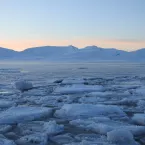Our Research
As climate changes, how do Earth's frozen areas affect our planet and impact society?
In this section
Related News & Stories
Filter by:

News Release
Arctic sea ice has likely reached its maximum extent for the year, at 14.62 million square kilometers (5.64 million square miles) on March 6, according to scientists at the National Snow and Ice Data Center (NSIDC) at the University of Colorado Boulder. The 2023 maximum is the fifth lowest in the 45-year satellite record.

Spotlight
As NASA moves their data, including data collections managed and housed at their 12 distributed active archive centers (DAACs), over to the Earthdata Cloud, the organization will lean on Openscapes. To support NASA DAAC researchers during the data migration to the cloud, Openscapes developed the Openscapes Framework, a scalable leadership training and community-building framework which includes three components: engaging DAAC mentors, empowering science research teams, and amplifying open science leaders.

Analysis - Snow Today
Continuing the trend of recent months, the western United States received significant snowfall in February 2023, helping to improve drought conditions in the West. Despite dominance of a La Niña conditions, current snowpack patterns resemble those characteristic of El Niño years.
Analysis - Sea Ice Today
Throughout February, Arctic sea ice extent tracked between second and fourth lowest in the satellite record while Antarctic sea ice extent tracked at record low extents.
Analysis - Sea Ice Today
On February 21, Antarctic sea ice likely reached its annual minimum extent of 1.79 million square kilometers (691,000 square miles).

News Release
Antarctic sea ice has likely reached its minimum extent for the year, at 1.79 million square kilometers (691,000 square miles) on February 21, 2023, according to scientists at the National Snow and Ice Data Center (NSIDC) at the University of Colorado Boulder. The 2023 minimum is the lowest in the 45-year satellite record.